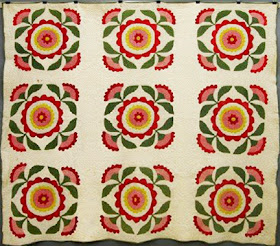Someone asked me about this pattern last year
and I couldn't find it in my Encyclopedia of Applique.
The patterns are categorized by construction
and this is one of the rather unusual designs that
has a large central image with four arms extending out to the corners.
Most applique designs have four elements growing out of the center north, east, south and west
plus four arms extending out to the corners, something I categorized as Four Plus Four...
As in this design numbered 22.41 in the Encyclopedia of Applique called Mexican Rose in the early 20th century pattern catalog from the Ladies' Art Company.
Where they sold it as an applique and a quilting pattern.
The closest thing I can find to the pattern of the day today
is their
Pumpkin
Ladies Art Company #508
My #12.68
It has the same concentric rings in the center with
four arms but little of the grace of the quilts
actually made in that pattern.
Of which I have found many.
Quilt by the exhibitor's great-great-grandmother,
Laura Ellen Davis Coffman, who lived in Salem, Indiana
See Lisa's blog here:Laura Ellen Davis Coffman, who lived in Salem, Indiana
http://inspiredquilter.blogspot.com/2010/11/quilting-through-ages-antique-quilt.html
There is variety in the centers, flowers, circles and pie crust like shapes
Online auction, possibly last quarter of the 19th century.
Found in the Ohio Quilt Project
The mid-19th century versions
tend to have fancier borders.
The pattern was one of those popular 19th-century designs
that seems never to have been published in the
20th century so it fell out of use.
This one's unusual in the colors reflecting the early 20th century
claret reds and indigo blues
rather than the mid-19th century Turkey red and green.
The tan was probably once green.
As in this one from the end of the 19th century.
Here's a fabulous mid-century example found in the New York State
Quilt Project. Note the heart shape in the
corner florals.
Similar heart shape in a quilt shown
at the Wisconsin Quilt Museum
And another from an online auction
Here's a 36" block with a fancy shape in the corners.
I guess that many of these floral centers were cut
like a snowflake. Fold a circle of fabric into twelve pie shape pieces.
Then scallop the edge with your scissors
And applique them down.
You do see that pie crust shape too without the corners
Particularly in mid-19th-century album samplers.
I think we should call it Pumpkin.
Read more about the Ladies Art Company at Connie Chung's webpage










f4BRRip,MuG!~~60_57.jpg)
!E9s2fDIHwBRRipzW-mw~~60_57.jpg)




Ts772!~~60_3.jpg)
























.jpg)

























